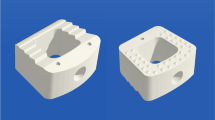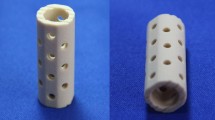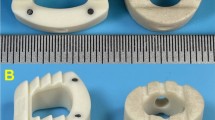Abstract
Purpose
The titanium mesh cage (TMC) is a typical metal cage device which has been widely used in cervical reconstruction for decades. Nano-hydroxyapatite/polyamide-66 (n-HA/PA66) cage is a novel biomimetic non-metal cage device growing in popularity in many medical centres in recent years. There has been no comparison of the efficacy between these two anterior reconstructing cages. The purpose of this study was to compare the radiographic and clinical outcomes of these two different devices.
Methods
Sixty-seven eligible patients with single-level ACCF using TMC or n-HA/PA66 cage for cervical degenerative diseases, with four-year minimum follow-up, were included in this prospective non-randomised comparative study. Their radiographic (cage subsidence, fusion status, segmental sagittal alignment [SSA]) and clinical (VAS and JOA scales) data before surgery and at each follow-up was recorded completely.
Results
The fusion rate of the n-HA/PA66 group was higher than TMC at one year after surgery (94 % vs. 84 %) though their finial fusion rates were similar (97 % vs. 94 %). Finial n-HA/PA66 cage subsidence was 1.5 mm with 6 % of severe subsidence over three millimetres, which was significantly lower than the respective 2.9 mm and 22 % of TMC (P < 0.0001). Lastly, SSA, VAS and JOA in TMC group were worse than in the n-HA/PA66 group (P = 0.235, 0.034 and 0.007, respectively).
Conclusions
The n-HA/PA66 cage is associated with earlier radiographic fusion, less subsidence and better clinical results than TMC within four years after one-level ACCF. With the added benefit of radiolucency, the n-HA/PA66 cage may be superior to TMC in anterior cervical construction.




Similar content being viewed by others
References
Malloy KM, Hilibrand AS (2002) Autograft versus allograft in degenerative cervical disease. Clin Orthop Relat Res 394:27–38
Siddiqui AA, Jackowski A (2003) Cage versus tricortical graft for cervical interbody fusion. A prospective randomised study. J Bone Joint Surg Br 85(7):1019–1025
Silber JS, Anderson DG, Daffner SD et al (2003) Donor site morbidity after anterior iliac crest bone harvest for single-level anterior cervical discectomy and fusion. Spine (Phila Pa 1976) 28(2):134–139
Tomford WW (1995) Transmission of disease through transplantation of musculoskeletal allografts. J Bone Joint Surg Am 77(11):1742–1754
Zdeblick TA, Ducker TB (1991) The use of freeze-dried allograft bone for anterior cervical fusions. Spine (Phila Pa 1976) 16:726–729
Riew KD, Rhee JM (2002) The use of titanium mesh cages in the cervical spine. Clin Orthop Relat Res 394:47–54
Majd ME, Vadhva M, Holt RT (1999) Anterior cervical reconstruction using titanium cage with anterior plating. Spine (Phila Pa 1976) 24(15):1604–1610
Eck KR, Bridwell KH, Ungacta FF et al (2000) Analysis of titanium mesh cages in adults with minimum two-year follow-up. Spine (Phila Pa 1976) 25(18):2407–2415
Chen Y, Chen D, Guo Y et al (2008) Subsidence of titanium mesh cage: a study based on 300 cases. J Spinal Disord Tech 21(7):489–492
Chen JF, Lee ST, Wu CT (2010) A hollow cylindrical PMMA strut for cervical spine reconstruction after cervical multilevel corpectomy. J Spinal Disord Tech 23(5):321–327
Kabir SM, Alabi J, Rezajooi K et al (2010) Anterior cervical corpectomy: review and comparison of results using titanium mesh cages and carbon fibre reinforced polymer cages. Br J Neurosurg 24(5):542–546
Yang X, Song Y, Liu L et al (2012) Anterior reconstruction with nano-hydroxyapatite/polyamide-66 cage after thoracic and lumbar corpectomy. Orthopedics 35(1):e66–e73
Zhao Z, Jiang D, Ou Y et al (2012) A hollow cylindrical nano-hydroxyapatite/polyamide composite strut for cervical reconstruction after cervical corpectomy. J Clin Neurosci 19(4):536–540
Barsa P, Suchomel P (2007) Factors affecting sagittal malalignment due to cage subsidence in standalone cage assisted anterior cervical fusion. Eur Spine J 16:1395–1400
Dorai Z, Morgan H, Coimbra C (2003) Titanium cage reconstruction after cervical corpectomy. J Neurosurg 99(1 suppl):3–7
Nakase H, Park YS, Kimura H et al (2006) Complications and long-term follow-up results in titanium mesh cage reconstruction after cervical corpectomy. J Spinal Disord Tech 19:353–357
Castellvi AE, Castellvi A, Clabeaux DH (2012) Corpectomy with titanium cage reconstruction in the cervical spine. J Clin Neurosci 19(4):517–521
Wang X, Li Y, Wei J et al (2002) Development of biomimetic nano- hydroxyapatite/poly(hexamethyleneadipamide) composites. Biomaterials 23(24):4787–4791
Huang M, Feng J, Wang J et al (2003) Synthesis and characterization of nano-HA/PA66 composites. J Mater Sci Mater Med 14(7):655–660
Xu Q, Lu H, Zhang J et al (2010) Tissue engineering scaffold material of porous nanohydroxyapatite/polyamide 66. Int J Nanomedicine 5:331–335
Niu CC, Liao JC, Chen WJ, Chen LH (2010) Outcomes of interbody fusion cages used in 1 and 2-levels anterior cervical discectomy and fusion: titanium cages versus polyetheretherketone (PEEK) cages. J Spinal Disord Tech 23(5):310–316
Ordway NR, Rim BC, Tan R et al (2010) Anterior cervical interbody constructs: effect of a repetitive compressive force on the endplate. J Orthop Res 30(4):587–592
Narotam PK, Pauley SM, McGinn GJ (2003) Titanium mesh cages for cervical spine stabilization after corpectomy: a clinical and radiological study. J Neurosurg 99(2 Suppl):172–180
Chuang HC, Cho DY, Chang CS et al (2006) Efficacy and safety of the use of titanium mesh cages and anterior cervical plates for interbody fusion after anterior cervical corpectomy. Surg Neurol 65(5):464–471
Acknowledgments
Conflicts of interest
The authors declare that they have no conflicts of interest concerning this article.
Device status/drug statement
The device(s)/drug(s) contained in this work is/are FDA approved or approved by corresponding national agency for this indication.
Funding sources/benefits received
No funds were received in support of this work. No benefits in any form have been or will be received from any commercial party related directly or indirectly to the subject of this article.
Author information
Authors and Affiliations
Corresponding author
Rights and permissions
About this article
Cite this article
Yang, X., Chen, Q., Liu, L. et al. Comparison of anterior cervical fusion by titanium mesh cage versus nano-hydroxyapatite/polyamide cage following single-level corpectomy. International Orthopaedics (SICOT) 37, 2421–2427 (2013). https://doi.org/10.1007/s00264-013-2101-4
Received:
Accepted:
Published:
Issue Date:
DOI: https://doi.org/10.1007/s00264-013-2101-4




